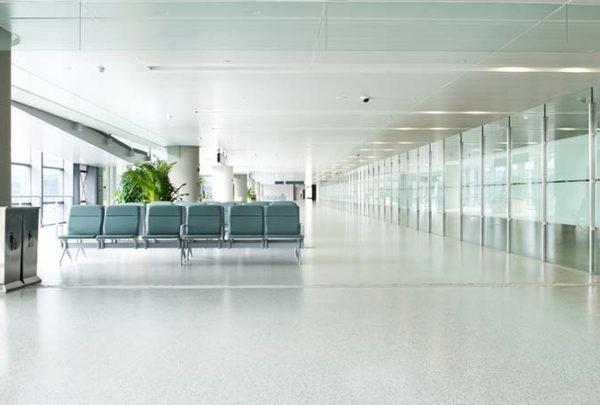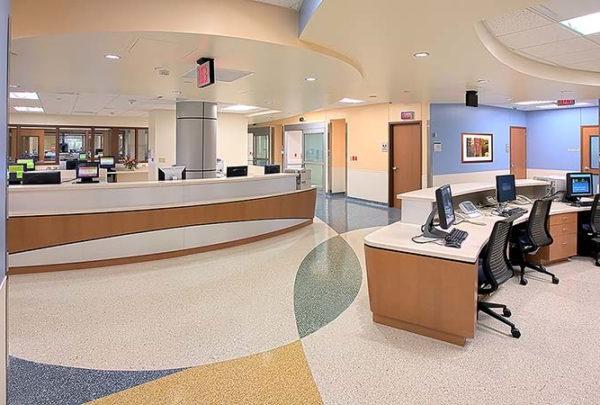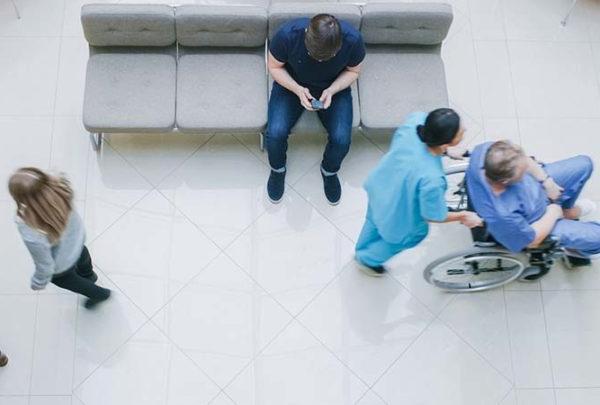The one thing that the current pandemic is teaching us is that technology is going to play a larger part in how healthcare is delivered in the future. Whether it’s an email from our medical provider, a commercial on TV, or a billboard on the side of the road, we are being notified that telehealth/telemedicine is available to us at the flip of a switch. While telehealth is consuming the conversation today, numerous other technological advances will radically change the physical built environment of the hospital in the future. Specifically, technology will have a significant impact on the square footage requirements within the acute care perioperative space.
Waiting Room
While probably the most obvious considering the current pandemic, the waiting room will most likely be the space most affected by new technology. Think of the hospital parking lot as you would the cellphone waiting lot at the airport. The future state will see patients and visitors notified via smartphone while sitting in their parked car that they can enter the facility, either for a scheduled appointment/registration or visiting a patient. The days of large waiting rooms and public spaces are most likely behind us, creating opportunities for facilities to reclaim space for revenue-generating functions. While these large spaces will slowly disappear, we are not to assume that hospitals will not have waiting rooms. They will just be dispersed equally as smaller sub-waiting areas throughout the facility to maintain proper social distancing and infection control.
Pre-Admission Testing (PAT)
While some systems and facilities have shifted pre-admission testing functions to the outpatient environment, a tremendous amount of hospital square footage is devoted to these suites across the country. Like traditional telehealth, technology is already being devoted to allowing patients to complete the pre-registration, screening, HIPAA compliance, and consultations typically done in PAT at their homes. Also, with the growth in the outpatient healthcare sector, many patients will be able to complete the required lab work either at their primary care physician’s office, remote testing lab, or through the use of a home health nurse. Just like we don’t expect waiting rooms to disappear, we don’t anticipate an elimination of PAT in the acute care setting, but we do see a significant downsizing of the overall department. We can assume that a much smaller footprint will be required for patients without access to telemedicine technology or those with significant comorbidities that will need a physical screening prior to procedure.
Surgical Robotics
The use of robotics within the surgical environment is not necessarily a new trend, but we believe it will continue to see an uptick in its future implementation. OR utilization is one of the key metrics analyzed when validating capacity and financial success within the surgical platform. The introduction of mobile robotics will allow surgeons maximum flexibility within the OR suite, creating a universal platform that will allow highly complex procedures to be done in virtually any room. Much like the universal patient room concept, this increased technology will cut down the need for creating highly specialized rooms that are dedicated to a singular service line (i.e., cardiac surgery, orthopedic surgery, neurosurgery). To maximize its effectiveness and increase utilization, we will most likely see a right-sizing of the operating room. The increasing use of mobile robotics and outpatient shift toward the ambulatory environment will likely lead to an increase in the size of the operating room (600-700 sf) to accommodate these highly complex cases.
Outpatient Surgery
The migration of outpatient surgical procedures from the primary acute hub into the ambulatory environment has been happening for years now, but it will continue to intensify over the next couple of years. More focus will be made to right-size the inpatient environment to accommodate the basic quaternary/tertiary services required within the hospital. While technology will not be the driver to make this decision for our healthcare partners, it will be technology that allows it to be successful. Significant changes to the technology systems and ultimately the sizing of the ASC and outpatient ORs will need to occur to accommodate more complex outpatient cases that were once completed within the hospital. While the ambulatory surgery environment will still be needed for the smaller (400-450 sf) operating rooms to handle minor procedures, the technology and case mix will most likely force a greater need for larger operating rooms as well.
This is just a sample of how technology will have an impact on the square footage requirements within healthcare. Research is currently being devoted to artificial intelligence and virtual reality work within the operating room that could be another disrupter to the current operational process and design. Stay tuned for more on this topic!








































































































